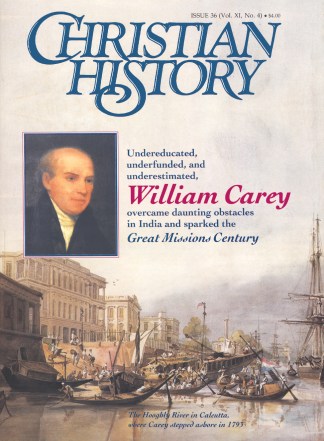In Carey’s day, some Hindus believed that when a man died, his widow should be burned with him. This was the only way the widow could win “eternal happiness.”
In 1799, Carey first encountered the practice:
“As I was returning from Calcutta I saw … a number of people assembled on the river-side. I asked them what they were met for, and they told me to burn the body of a dead man. I inquired if his wife would die with him; they answered Yes, and pointed to the woman. She was standing by the pile, which was made of large billets of wood, about 2 1/2 feet high, 4 feet long, and 2 wide, on the top of which lay the dead body of her husband. Her nearest relation stood by her, and near her was a small basket of sweetmeats called Thioy.
“I asked them if this was the woman’s choice, or if she were brought to it by any improper influence? They answered that it was perfectly voluntary. I talked till reasoning was of no use, and then began to exclaim with all my might against what they were doing, telling them that it was a shocking murder. They told me it was a great act of holiness, and added in a very surly manner, that if I did not like to see it I might go further off, and desired me to go. I told them that I would not go, that I was determined to stay and see the murder, and that I should certainly bear witness of it at the tribunal of God.
“I exhorted the woman not to throw away her life, to fear nothing, for no evil would follow her refusal to burn. But she in the most calm manner mounted the pile, and danced on it with her hands extended, as if in the utmost tranquility of spirit. Previous to her mounting the pile, the relation whose office it was to set fire to the pile, led her six times round it.… As she went round she scattered the sweetmeats above mentioned among the people, who picked it up and ate it as a very holy thing.
“This being ended, … she lay down by the corpse, and put one arm under its neck and the other over it, when a quantity of dry cocoa-leaves and other substances were heaped over them to a considerable height, and then Ghee, or melted preserved butter, poured on the top. Two bamboos were then put over them and held fast down, and the fire put to the pile, which immediately blazed very fiercely, owing to the dry and combustible materials of which it was composed.
“No sooner was the fire kindled than all the people set up a great shout—Hurree-Bol, Hurree-Bol, which is a common shout of joy, and an invocation of Hurree, the wife of Hur or Seeb. It was impossible to have heard the woman had she groaned, or even cried aloud, on account of the mad noise of the people, and it was impossible for her to stir or struggle on account of the bamboos which were held down on her like the levers of a press.
“We made much objection to their using these bamboos, and insisted that it was using force to prevent the woman from getting up when the fire burned her. But they declared that it was only done to keep the pile from falling down. We could not bear to see more, but left them, exclaiming loudly against the murder, and full of horror at what we had seen.”
Copyright © 1992 by the author or Christianity Today/Christian History magazine. Click here for reprint information on Christian History.










